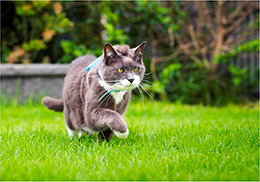09 February 2017
 The secret lives of cats are revealed in the University of South Australia’s final report for the Cat Tracker project, a citizen science initiative designed to help cat owners make informed decisions about the care and management of their pet cats in South Australia.
The secret lives of cats are revealed in the University of South Australia’s final report for the Cat Tracker project, a citizen science initiative designed to help cat owners make informed decisions about the care and management of their pet cats in South Australia.
Led by Discovery Circle Research Leader, UniSA’s Dr Philip Roetman, the Cat Tracker project focused on cat movement and cat management issues. The research team worked with the community, using small GPS units to track the movement of hundreds of pet cats. Additionally, a survey of the South Australian community asked questions about cat management, including views on containing cats at night and limiting the number of cats permitted per household.
“Cat Tracker involved more than 3000 members of the South Australian community, analysing the tracks of 428 cats, including 61,250 location data points. And our survey data includes rich information about 4314 cats,” Dr Roetman says.
“We couldn’t get this amount of information without the wonderful support and contributions from cat owners.
When we put the cats’ tracks online we were all surprised to see how far they travelled.
“The median home-range for the cats was tracked was 1.04 hectares (10,400 square metres), which is approximately half the playing surface at the Adelaide Oval.
“Night-time home-ranges were significantly larger than day-time home-ranges, and 88 per cent of cats had larger home-ranges at night.
“We found that about 40 per cent of the cats that had been classified by their owners as being kept inside at night, had in fact been out and about with night-time home-ranges of over one hectare (10,000 square metres).”
Dr Roetman says that the research also revealed five major personality factors for pet cats including skittishness, outgoingness, dominance, spontaneity and friendliness.
“We provided cat owners with reports about their cats’ personalities which can help owners make decisions about cat management,” Dr Roetman says.
“So, for example, if an owner has a particularly skittish cat, they might decide to provide extra hiding places for their pet, to make the cat more comfortable.”
The Cat Tracker project was developed by UniSA in collaboration with the Dog and Cat Management Board and local partners including the City of Marion, City of Mitcham, City of Salisbury, the Adelaide and Mount Lofty Ranges Natural Resources Management Board, and the Department of Environment, Water and Natural Resources. International partners included the North Carolina State University, North Carolina Natural History Museum and the Victoria University Wellington.
Chair of the Dog and Cat Management Board, Dr Felicity-Ann Lewis, says attitudes towards cat management are changing and there is a growing expectation that cats should be managed in a similar way to dogs.
“This report provides us with a clear picture of how people feel about cats and cat management, and also an understanding of how far cats can roam,” Dr Lewis says.
“We hope that having seen these results, more owners will choose to keep their cats inside at night and that local councils will consider including cat curfews within their cat by-laws.”
Environment Minister Ian Hunter said the project was useful and interesting.
“We know that South Australians love their cats and it is really fascinating to see where our moggies are going on their travels.
“The State Government is committed to encouraging responsible pet ownership through the current suite of legislative reforms, such as compulsory microchipping to help reunite families with their lost pets and de-sexing to reduce the number of unwanted cats and dogs arriving in shelters.”
Dr Roetman says it’s been rewarding to work with the community to find out so much about our pet cats.
A summary of the results, a project report and maps of cat tracks will be available on the Discovery Circle website on Tuesday 7 Feb 2017: http://www.discoverycircle.org.au/projects/cat-tracker/results/
Dr Roetman is now collaborating with a research team around Australia and seeking funding to run a national Cat Tracker project in the near future. Interested councils, state governments, organisations and individuals should contact the Discovery Circle at discoverycircle@unisa.edu.au
Contact for interview: Dr Philip Roetman office (08) 8302 1081 email philip.roetman@unisa.edu.au
Media contact: Annabel Mansfield office (08) 8302 0593 (Mon/Fri) (08) 8302 0578 (Tues/Wed)
mobile: 0417 717 504 email: Annabel.Mansfield@unisa.edu.au



